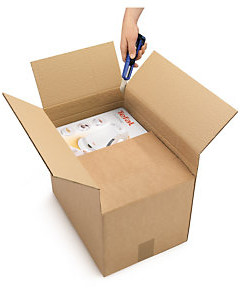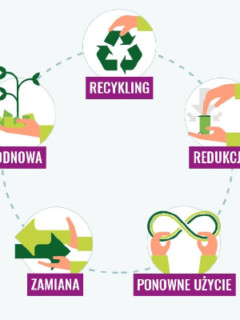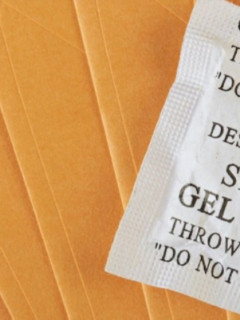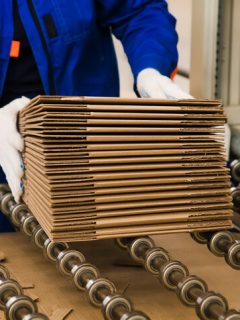Ecology is not a passing trend, as many enthusiasts of this science are proving. People are becoming increasingly aware of the state of the environment – concern for its well-being is no surprise and is expressed in small gestures, actions. The courier, e-commerce and packaging industry is not lagging behind. There are more and more ways to package shipments in an environmentally friendly way. What does this look like in practice?
What do we define as ecological packaging?
Ecological packaging is 100% environmentally safe, biodegradable. What does this mean exactly? The disposal, use, as well as the manufacturing process of the box and the material from which it is made do not contribute to the pollution of nature.
Do you want to know which packaging is the least polluting? As you might guess, the most popular types of eco-friendly packaging are boxes, created from a variety of materials, including paper and corrugated cardboard, solid cardboard, as well as grass, vegetable starch, cellular glass, hemp.
It is also worth mentioning rPET, a special, stable, indestructible, fully food-safe material made from recycled PET bottles. Its production does not consume much energy and does not emit carbon dioxide.
Ecological cardboard packaging – the most popular type
Wondering why you should choose ecological cartons and packaging? Among other things, they do not litter the environment, they have a positive impact on brand image.
Most ecological packaging is made of paper and cardboard (corrugated or solid). Both valuable raw materials are made from renewable, carbon-neutral material. They can be easily recycled. They are reusable materials. Corrugated cardboard boxes (3-layer, 5-layer or 7-layer) can be used for heavier items as well as for lighter, more delicate ones. Ecological packaging made of solid cardboard is used in the confectionery, pharmaceutical and food industries.
What are the other eco-friendly packaging materials?
Although cardboard boxes play the largest role in the packaging sector, other helpful materials should not be forgotten, from which films, fillers, among others, are produced. Examples of biodegradable raw materials are:
- Cellulose glass – a type of compostable, renewable plastic. It is made from cellulose. This material is crystal clear, breathable and highly tear-resistant. Although it resembles plastic at first glance, it has properties like paper. In the packaging industry, cellulose glass is used to make bags and films.
- Plant starch – a renewable raw material derived from maize or potatoes (potato starch, maize starch). It is used to produce compostable, completely biodegradable plastics. Plant starch has similar properties to synthetic products. It decomposes non-toxic, environmentally safe (when exposed to air and light) over a period of 9-60 months. In the packaging industry, it is most commonly used for a variety of parcel fillers, airbag films.
- Hemp – requires no fertiliser and can be fully recycled. They have properties similar to polystyrene, so are readily used to protect goods.
- Grass – a versatile material with high tear resistance. Its fibres produce a distinctive paper used for packaging. It is used to make lightweight boxes and mending paper.
Not just cardboard boxes. Ecological parcel fillers
Ecological parcel fillers are indispensable for the ecological packaging of parcels. These include paper fillers (e.g. tissue paper, SizzlePak), or the characteristic polystyrene crisps (Skropak).
The packaging industry used to rely mainly on bubble wrap or polystyrene crisps. Nowadays, an alternative to the former can be found in bubble paper – a modern material that is gradually winning the hearts of customers and e-commerce companies. It is characterised by excellent cushioning properties or high absorbency. An interesting option is also ecological wrapping paper – Kraft paper.
What is worth knowing about plain tissue paper?
Plain tissue papercombines functionality and decoration. Smooth tissue paper can be used to protect (inside) and decorate (outside) mailings. Plain tissue paper is distinguished by its durability and elasticity. Like ecological stretch film, it adheres perfectly to wrapped items, effectively protecting them from damage. It can be purchased in sheet form or as coloured pressed tissue paper, often used by companies that plan to implement a visual brand identity plan.
SizzlePak eco-friendly filler – benefits, uses
SizzlePak filler is a unique quality in the packaging industry. It is convenient to store, efficient (when removed from the packaging, it increases its volume by almost 300%). It is created from spiral paper fibres, 80% recycled. SizzlePak filler takes the form of distinctive zigzags – holding its shape well, resistant to crumpling, made up of 2 layers of anti-static wrapping paper.
Wondering if fillers can be eco-friendly and decorative at the same time? Yes. SizzlePak is the answer to this question. It will not only serve as a classic filler, cushioning the package from the inside. It can be used for elegant, striking, eco-friendly gift packaging – no wonder it has its share of corporate gift packaging, gift baskets.
Eco-friendly Skropak
Skropak is another highly regarded, biodegradable, compostable parcel filler. It is characterised by its lightness, strength and anti-static properties. It is 100% environmentally safe, made from plant-based ingredients.
Skropak comes in the form of packaging crisps – an alternative to polystyrene crisps. It fulfils the most important function of an environmentally friendly parcel filler – protecting parcels during transport and minimising any damage during transit that could occur due to goods moving around inside the carton.
How to pack parcels with respect for ecology – step by step? What is ecological packaging?
Ecological parcel packaging takes into account the “zero waste” philosophy. The first step – acquiring a cardboard box – can be done in two ways: by using cardboard boxes (e.g. shoe boxes, from grocery shop warehouses) that are lying around the house, or by buying new cardboard packaging from a respected manufacturer.
As for fillers, it is a good idea to collect them every time you receive a parcel. Most e-commerce companies use bubble wrap, foil airbags. Although these fillers are not among the most environmentally friendly, they can be used repeatedly. Your own parcel filler can be crumpled old newspapers or cut up cardboard – they are not as effective and aesthetically pleasing, but are more likely to do the job.
The final stages of eco-friendly parcel packaging are sealing the edges with adhesive tape and then – possibly – wrapping them in eco-friendly stretch film. Instead of traditional adhesive tape, it is worth using an alternative – paper adhesive tape or jute twine.













